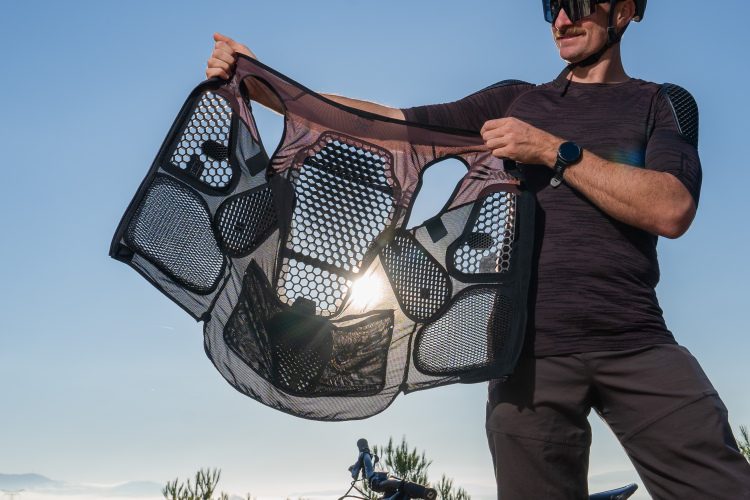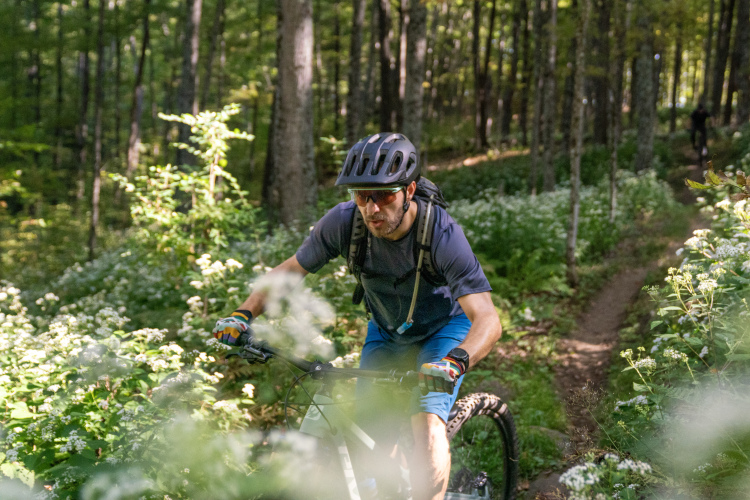
Vittoria is one of the latest companies to offer a mountain bike tire insert for use with tubeless bike tires. The company says Air-Liner “increases control, durability, performance, and protection of both tire and wheel,” which on the surface sounds like a pretty tall order. I decided to investigate to see how these claims hold up.
But first, I needed to install the inserts in my tires.
Installation

Based on Aaron’s experience with installing CushCore tire inserts, I was reluctant to give this a shot. Not only that, Air-Liner inserts require the added step of sizing and cutting the liner to fit various wheel diameters. The Vittoria liner is shipped like a folded up pool noodle, not a hoop like some other products on the market.
Fortunately, the instructions included in the package are Ikea-style and dead simple to follow. Loop the Air-Liner around a bare rim, mark the overlap, and cut. I was worried I wouldn’t get the length exactly right, but fortunately it seems the tolerances don’t need to be super tight.

Next, poke a hole through the center channel on both ends, about an inch or so from the edges. Again, this doesn’t have to be super accurate. I used a Phillips screwdriver to make the holes. Use the included zip tie to secure the two ends together and it’s on to mounting.

I placed the Air-Liner inside a brand new tire and started by fitting the bead onto one side of the rim. Next, I started working the other side just like I would with a normal tire. Getting the bead down into the rim channel requires compressing the liner a bit, but doesn’t involve a lot of force. The first tire went without a hitch, and I was able to do the whole thing by hand without the help of a tire lever. The second one was a little trickier, but all it took was a couple of final pries with a lever to get the tire in place.
In some ways, I actually think the Air-Liner makes installing tires easier than usual. The foam gives the tire some shape and helps secure the bead as I work my way around the tire. Before airing them up, the tires even look inflated. I didn’t need to get out my air compressor to mount the tires tubeless the first time; the Air-Liner helps jam the bead in enough to allow a floor pump to do its work.
Un-installation is a whole ‘nother situation.
Air-Liner does a great job keeping the tire and bead tightly in place, but the downside is this makes changing the tire a real pain. Wedging a lever under the bead is near impossible without compressing and pulling the tire and Air-Liner away from the rim.


Ultimately I used a woodworking speed clamp to compress the Air-Liner and also to provide a handle so I could get some leverage on the tire. Pushing the clamp perpendicular to the rim, I was able to fold the tire and liner enough to get a skinny lever under the bead. From there, the tire came off as usual.
The speed clamp method works great, but what about trailside repairs? Removing a tire with an Air-Liner inside should be pretty doable, assuming you have a buddy with you. One person can use both hands to pull the tire and liner away from the rim, while the other jams a lever under the bead. Of course, the whole idea behind Air-Liner is to avoid the need for trailside tire fixes in the first place, so while un-installation is a pain, chances are users won’t have to go through the process often.
Design and construction

At a glance, Air-Liner might look familiar, say if you’ve been playing at the pool recently. But there’s actually a lot going on here.
For starters, Air-Liner is made from a “high-quality polymer” which has been chosen for its light weight, its ability to resist absorbing liquids (sealant), and its elasticity. It’s surprisingly firm and yet lightweight.
Unlike other inserts on the market, Vittoria went with a round profile which they say maximizes surface contact with sidewalls and mimics the general shape of an inflated tire. Two channels, top and bottom, allow the liner to deform in a progressive manner on impact. The bottom channel ensures the liner is compatible with all of the various tubeless tire valve configurations on the market. Holes are periodically spaced within the channel to allow sealant to reach all parts of the tire.
Vittoria offers four sizes based on tire width: small for XC tires, medium for trail tires, large for enduro/plus tires, and extra large for fat tires. Each insert is long enough to fit any size wheel, from kids bikes all the way up to 29ers. Just cut to size.
On the trail
As I said at the start, Vittoria makes several claims about the benefits to running Air-Liner inserts, which I was able to test for myself.
Increased control
One of the first things fat bike riders notice is how bouncy high-volume tires can be, particularly at low pressures. Vittoria (and other tire insert manufacturers) claim an insert displaces air volume in the tire and effectively damps tire rebound, giving riders increased control.
I tested the Air-Liners on a full-suspension bike with standard 29er wheels running 2.35″ tires where tire bounce isn’t all that noticeable to begin with, especially running pressures in the 20-30psi range. On a hardtail, or with a fatter tire, it’s possible the damping effect would be more noticeable, but in my tests, there wasn’t any appreciable difference.
Durability

I’m the kind of guy who sees the word durability and thinks, “this better last not just for a season, but for years.” For that reason, I avoid even talking about durability in product reviews because it’s just not feasible to hold onto a product long enough to come to a verdict. By the time a true durability test is complete, two new revisions of the product are already on the market!
There are actually two durability claims at play here. The first, most obvious one is the durability of the Air-Liner itself. Vittoria says the product should last for 2,000 hours of riding OR 1-hour of flat-tire riding. Like tires themselves, tire liners don’t last forever and will need to be replaced. Fiddling with a small piece of the material, it’s obvious the polymer has a memory so over time, it will deform, and rapidly so if ridden in extreme conditions like in a flat tire situation.
Air-Liner seems well-suited to improving tire durability as well. Tires flex a lot over the course of a trail ride, and over time those flex points tend to wear out and break down. This is particularly true of sidewalls, and inserts help sidewalls maintain their shape through bumps and jabs.
Performance

Running lower air pressures can make tires grippier and more supple, but beyond a certain point, they start to feel squirmy and floppy. This is particularly true of taller, higher-volume tires like plus tires, or lightweight tires with thinner sidewalls. Tire inserts seek to reduce tire squirm by reinforcing sidewalls.
Perhaps because of the round profile, I found the Vittoria tire inserts don’t do a whole lot for me in terms of improving side-to-side stability at low pressures. With under 20psi in my rear tire, cornering felt sketchy AF as the tire simply wrapped itself around the insert. At higher pressures, I rarely experience tire roll anyway, so I don’t see a lot of benefit here.
Protection

This is where the Air-Liners truly shine, so much so that I really wish they had listed this benefit first. If reading the previous sections makes it sound like I’m lukewarm about these tire inserts, get ready because I’m about to add a kettle of boiling water to the mix.
If someone has a mechanical issue on the trail, roughly nine times out of ten* it involves a tire and/or wheel. (*According to my own non-scientific observations.) Tubeless tires go a long way toward eliminating a lot of the flats associated with tubes, but pinch flats and burps are still a fact of life. Air-Liner pretty much does away with both.
Even if a tire completely loses pressure, the Air-Liner insert allows the ride to go on, albeit not quite as fast or as comfortably as on a properly-inflated tire. With no air in the front tire, a short test ride felt pretty decent, though the crunchy sound of the tire on dirt just seemed wrong. With zero pressure in either tire, I was still able to roll safely up and downhill, through I had to be super careful in the turns. Run-flat protection is really an emergency-use feature, but it could possibly help riders avoid dangerous high speed blowouts or make the difference between getting home before dark or spending a night wandering in the woods.
While carbon fiber rims are becoming more affordable, riders are still cautious about damaging them through rough riding. Air-Liners are basically bubble wrap for rims, carbon or aluminum, and should all but eliminate dings and dents.
So what does this mean in practice? For me, it means added confidence on the trail. With Air-Liners in my tires, I didn’t hesitate to attempt riding up a set of stairs on a recent group ride. I pushed myself faster and harder through chunky, jagged stretches of trail. Subconsciously, I think I even relaxed a little bit, knowing I was less likely to get a flat tire, and even if I did get one, I would have no problem salvaging the ride.
Worth it?
Benefits aside, there are clearly some costs involved in running Vittoria Air-Liners.
The first is the monetary cost. Depending on the size, Air-Liner is priced from $85 to $95 per wheel. That’s about the cost of a premium tire.
The second cost is the weight penalty. Again, depending on the size and final diameter, Air-Liner adds between 90g and 234g per wheel. While significant, it’s not uncommon to find tires whose weights vary by more than this amount depending on construction. For example, riders may find they can run the light version of a particular tire with Air-Liners and get similar performance to a standard or tough version of the tire. I can honestly say the Air-Liners didn’t add any appreciable weight to my bike, and the wheels felt just as quick to accelerate as ever.
Finally, there’s the potential hassle involved in installation and repair. While I found installation to be fairly simple, adding an Air-Liner does add time and complexity. While I didn’t run into any issues on the trail, it seems dealing with a flat on a big ride could be a real hassle compared to a standard tire setup. However, it also seems likely that Air-Liner will prevent many of the tire issues that could lead to a trailside repair in the first place.
With all of this in mind, I personally think Vittoria Air-Liners are a welcome addition. The peace of mind alone is worth a lot to me, and I’m really pleased with how easy the product is to use. I plan to run my tire inserts for a long time.
Buy Vittoria Air-Liner Tire Insert
Thanks to Vittoria for providing the Air-Liner tire inserts for review.










8 Comments
Aug 22, 2018
Oct 22, 2018
I won't be able to put additional time on Cush Cores; my only experience with them is a brief ride at Sea Otter.
Oct 22, 2018
Could you say more now?
I like Cushcore but it's too heavy and I don't ride park. Huck Norris don't give enough protection but seems to have helped against burping a bit.
Interested in Panzer, Vittioria air liner and Nukeproof ARD.
Aug 22, 2018
Feb 15, 2019
Feb 15, 2019
Feb 15, 2019
Aug 23, 2018